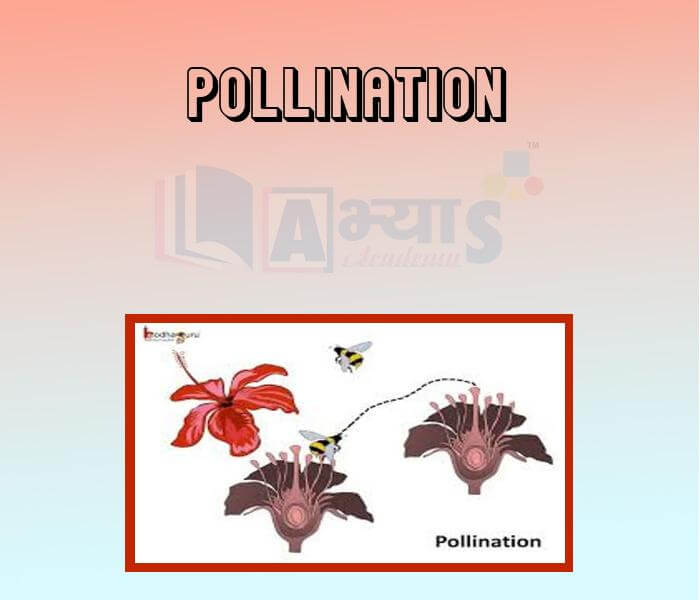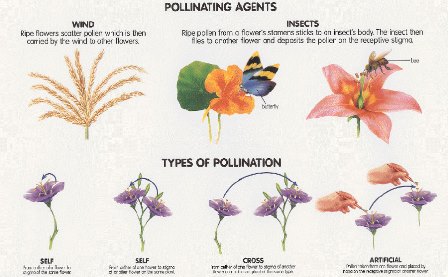Pollination





Pollination
Pollination The transfer of pollen grains from the anther to the stigma is known as pollination. When the anthers grow and mature; they burst open and release pollen grains (male gametes). These pollen grains are then carried to the stigma (female part) of another flower (of the same type) by insects, birds, wind or water. Insects and birds visit flowers to collect nectar and they are called as pollinators. While collecting nectar from a flower, some pollen grains stick to their wings and legs and get transferred to the flower on which they sit. This transfer of pollen grains from one flower to another of the same kind is called pollination. The process of pollination can occur in two ways:
Cross-pollination: The transfer of pollen grains from the anther of one flower to the stigma of another flower of another plant of the same type is known as cross-pollination. Cross-pollination can be observed in plants of maize, coconut, grasses, etc.
Self-pollination: The transfer of pollen grains from the anther to the stigma of the same flower or to the stigma of another flower on the same plant, it is termed as self-pollination. It can be seen in pea, rice, wheat, etc.
Agents Of Pollination: - wind, water and insects.
Wind: Wind blows away pollen grains from the anthers of one flower to the stigma of another flower. Pollen grains are very light. E.g. wheat, rice and maize.
Water: Water pollinated flowers release their pollen grains into the water and slowly carried to other flowers by water currents. E.g. sea grass.
Insects: Some pollen stick to the body parts of the insect .when these insects visit another flower, the pollen grains fall on the stigma .e.g. sweet pea, orchids and jasmine.

For self - pollination, a flower should be __________________ | |||
| Right Option : D | |||
| View Explanation | |||
Which of the following are correct ? (a) The transfer of pollen grains from the anther to the stigma is known as pollination. When the anthers grow and mature; they burst open and release pollen grains (male gametes). (b) The pollen grains are carried to the stigma (female part) of another flower (of the same type) by insects, birds, wind or water. (c) Insects and birds visit flowers to collect nectar and they are called as pollinators. | |||
| Right Option : D | |||
| View Explanation | |||
Which one is not the medium of dispersal and pollination? | |||
| Right Option : D | |||
| View Explanation | |||
Students / Parents Reviews [10]
About Abhyas metholodology the teachers are very nice and hardworking toward students.The Centre Head Mrs Anu Sethi is also a brilliant teacher.Abhyas has taught me how to overcome problems and has always taken my doubts and suppoeted me.

Shreya Shrivastava
8thMy experience with Abhyas academy is very good. I did not think that my every subject coming here will be so strong. The main thing is that the online tests had made me learn here more things.

Hiya Gupta
8thI have spent a wonderful time in Abhyas academy. It has made my reasoning more apt, English more stronger and Maths an interesting subject for me. It has given me a habbit of self studying

Yatharthi Sharma
10thMy experience was very good with Abhyas academy. I am studying here from 6th class and I am satisfied by its results in my life. I improved a lot here ahead of school syllabus.

Ayan Ghosh
8thAbhyas Methodology is very good. It is based on according to student and each child manages accordingly to its properly. Methodology has improved the abilities of students to shine them in future.

Manish Kumar
10thIt was good as the experience because as we had come here we had been improved in a such envirnment created here.Extra is taught which is beneficial for future.

Eshan Arora
8thBeing a parent, I saw my daughter improvement in her studies by seeing a good result in all day to day compititive exam TMO, NSO, IEO etc and as well as studies. I have got a fruitful result from my daughter.

Prisha Gupta
8thAbhyas is a complete education Institute. Here extreme care is taken by teacher with the help of regular exam. Extra classes also conducted by the institute, if the student is weak.

Om Umang
10thA marvelous experience with Abhyas. I am glad to share that my ward has achieved more than enough at the Ambala ABHYAS centre. Years have passed on and more and more he has gained. May the centre flourish and develop day by day by the grace of God.

Archit Segal
7thIt has a great methodology. Students here can get analysis to their test quickly.We can learn easily through PPTs and the testing methods are good. We know that where we have to practice
